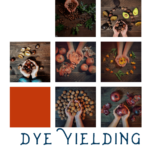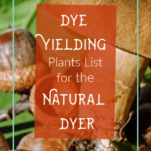This post contains affiliate links. I could be an affiliate for many different products, but I chose these specifically because they are the products and brands I like and recommend. By using my links, you help support this website.
This natural dyeing plant list is a compilation of plants and other organic materials that can be used for natural dyeing. Use this list as a guide to certain plants’ potential uses and outcomes. This compilation includes details on the following:
- Latin names
- Colors produced
- Tutorial suggestions
- Seed sources
- And more
Flowers, leaves, bark, roots, bugs, and kitchen scraps make beautiful colors.
This is a growing compilation of resources and potential dye plants.
Table of Contents:
Natural dye materials from the kitchen
Natural dye materials from the garden
Natural dye materials gathered
Natural dye powders and extracts
Natural dye materials by color produced
What are dye plants?
Natural dyeing is the art of taking organic materials, extracting color from those materials, and applying the color to fiber, yarn, or cloth.
The color adheres to the fibers of the material you are dyeing, transforming it into a beautiful piece of art.
Natural dyes are somewhat unpredictable, and each one acts in unique ways.
Some natural dyes are lightfast; they maintain their color even after prolonged exposure to sunlight. Some natural dyes are fugitive, meaning they will slowly fade over time.
The joy of dyeing naturally comes from experimentation, the unknowns, and the crafting of a color. It is an art form that takes patience, diligence, a free spirit, and a sense of creativity and flexibility.
Plants are full of life and interest. Not only does a plant grow from a tiny little seed, but it helps to clean our air and develop fruits, veggies, or other eatables. For the natural dyer, it also opens a world of possibilities for color.
Where to buy dye plants?
Some natural dyeing plants and products can be sourced from your kitchen cupboards, others on the roadside. Some are ordered as dried dye material from natural dyeing suppliers. And if you are ambitious and want to dive in, try planting some of your dye plants.
I have compiled a list of my favorite resources for natural dyeing in Natural Dyeing Resources for the Modern Dyer. Check it out to find places to purchase your natural dyeing materials.
Also included under some of the dye material profiles is a suggestion for where to source seeds for planting your dye plants and where to find a powdered or dried version of challenging-to-find products.

How to dye using plants
Under each dye material profile, I have tried to include at least one tutorial on how to dye using that material.
Some dyes are less common, and tutorials are hard to find; others are common, and there are many tutorials to choose from. I have included a few that I find helpful and include enough information to get you started.
Also, check out Natural Dyeing: How to Make Beautiful Natural Dyes, an overview of natural dyeing, and the basic steps for creating natural dyes.
A list of dye-yielding plants
Each item on this list includes the following information if I could source it.
- Latin name of the plant for easier identification
- Potential color produced
- Tutorial suggestions on how to dye with the plant
- Source for raw dyestuff or powders
- Source for seeds to grow the plant
Use this information to pursue your natural dyeing experiments. Check out Textile Indie’s other Natural Dyeing resources for more details.
Use the button below to download a printable list of dyeing materials.
Natural dye materials from the kitchen
Avocado pits
Latin name: Persea americana
Color produced: pinkish tan
Tutorials:
Rebecca Desnos – Avocado Dye: FAQs / Top tips for pink
Live Free Creative Co. – How to Dye with Avocado Pits
Avocado skins
Latin name: Persea americana
Color produced: pinkish tan

Beets
Latin name: Beta vulgaris
Color produced: Purplish brown
Source for seeds: Territorial Seed Company
Tutorials:
Gage Hill Crafts – Dye Wool with Beets
Viking Lady Aine – Beetroot…Not What You Might Expect
Berries
Color produced: range of pinks and purples (berries are not colorfast)
Tutorials:
Seamwork – Dyeing Fabric with Fruit
Blackberries
Latin name: Rubus fruticosus
Color produced: purple
Tutorials:
Woodlark – DIY Natural Dyeing with Blackberries
Black beans
Latin name: Phaseolus vulgaris
Color produced: purple
Tutorials:
Hooked and Dyed – Black Bean Dye
A Polish Granddaughter – Natural Dyeing – In Search of Blue using Black Beans
Solar dyeing with black beans:
Knitbyahenshop – Natural dye tutorial: blue yarn from black beans!
Black tea
Latin name: Camellia sinensis
Color produced: brown
Tutorials:
Textile Arts Center – Tutorial: Dying with Black Tea
Rebecca Desnos – Painting with Milk and Dyeing with Tea
Woodlark – DIY Natural Dyeing with Tea
Coffee grounds
Latin name: Coffea
Color produced: brown
Tutorials:
The Spruce Crafts – How to Dye Clothes Tan or Brown with Coffee
Carrot tops
Latin name: Daucus carota subsp. sativus
Color produced: light green
Source for seeds: Territorial Seed Company
Citrus peels
Latin name: Citrus
Color produced: pale yellow
Cherries
Color produced: pink
Chamomile tea
Latin name: Matricaria chamomilla
Common name: German Chamomile
Color produced: pale yellow, light tan
Source for seeds: Territorial Seed Company
Tutorials:
Apple Oak Fibre Works – Chamomile Dye
Hibiscus tea
Latin name: Hibiscus rosa-sinensis
Color produced: light pinks and purples
Tutorials:
MaRI Collective – Natural Dyeing with Hibiscus Using Alum as Modifier
Peach pits
Latin name: Prunus persica
Color produced: pale yellow and tan
Pomegranate
Latin name: Punica granatum
Color produced: tan
Tutorials:
Wild Colours – Dyeing with Pomegranate
Folk Fibers – Natural Dyes: Pomegranates
Red cabbage
Latin name: Brassica oleracea var. capitata f. rubra
Color produced: purples, pinks, and blues (red cabbage is not light and wash fast)
Source for seeds: Territorial Seed Company
Tutorials:
Sew Historically – How to Dye Blue with Red Cabbage- Tutorial
Red onion skins
Latin name: Allium cepa
Color produced: ranges from reddish tan and olive green when dipped in iron water
Source for seeds: Territorial Seed Company
Tutorials:
Crafternoon Treats – Natural Dyeing with Onion Skins
Little House on the Prairie – How to Create the Green Yarn from “Christmas at Plum Creek”
Rebecca Desnos: Red Onion Skin Magic

Rooibos tea
Latin name: Aspalathus linearis
Color produced: tan
Tutorials:
Natural Suburbia – Natural Wool Dyeing with Rooibos Tea
Spinach
Latin name: Spinacia oleracea
Color produced: pale yellowy green
Source for seeds: Territorial Seed Company
Tutorials:
Timber Creek Farm – Using Spinach Dye for Natural Wool Color
Turmeric
Latin name: Curcuma longa
Color produced: bright yellow to orange
Source: Amazon
Tutorials:
Kat Makes – Natural Dyeing Experiments: Turmeric Part 1
Turmeric Australia – How to Make Turmeric Fabric Dye
The PlantHunter – DIY: Dyeing with Turmeric
Yellow onion skins
Latin name: Allium cepa
Color produced: deep yellow to tan
Source for seeds: Territorial Seed Company
Tutorials:
Folk Fibers – Natural Dyes: Yellow Onion Skins
It’s a Stitch Up – Natural Dyeing with Onion Skins

Natural dye materials from the garden
Calendula
Latin name: Calendula officinalis
Color produced: yellow
Source for seeds: Territorial Seed Company
Tutorials:
Wingham Wool Work – Dye Calendula
Kimberly Baxter Packwood – Notes on Natural Dyeing. Notes on how to dye with calendula at the end of the post.

Daffodils
Latin name: Narcissus
Source for bulbs: Baker Creek Heirloom Seeds
Tutorials:
Wool Tribulations of Hand Spinning and Herbal Dyeing – A Trial of Daffodil Petal Dye
Dahlia
Latin name: Dahlia
Color produced: tan
Source for seeds: Baker Creek Heirloom Seeds
Tutorials:
Maker Gardener – Fabric Dyeing Using Dahlia and Alum Mordant
Dandelion
Latin name: Taraxacum
Color produced: yellow to tan
Tutorials:
Elderberries
Latin name: Sambucus nigra
Color produced: brownish purple
Source for seeds: Territorial Seed Company
Tutorials:
That Crafty Bitch: Plant Dyes Elderberry
Eucalyptus leaves
Latin name: Eucalyptus
Color produced: range of colors depending on process
Tutorials:
Sally Blake – Eucalyptus dye database
Rebecca Desnos – Triple bundle dyeing with eucalyptus leaves
Fennel leaves
Latin name: Foeniculum vulgare
Color produced: yellow
Source for seeds: Territorial Seed Company
Tutorials:
The Practical Herbalist – DIY Herbal Dyes: Fennel on Animal Fiber
Hibiscus flower
Latin name: Hibiscus rosa-sinensis
Color produced: pale purples and pinks
Ivy
Latin name: Hedera helix
Tutorials:
Wool Tribulations of Hand Spinning and Herbal Dyeing – A Trial of Ivy Leaf Dye
Lavender
Latin name: Lavandula angustifolia
Color produced: silver gray
Source for seeds: Territorial Seed Company

Mint
Latin name: Mentha
Color produced: pale yellow
Source for seeds: Territorial Seed Company
Tutorials:
Rosemary
Latin name: Salvia rosmarinus
Color produced: gray to light brown
Source for seeds or plants: Territorial Seed Company
Tutorials:
Cozy Homemaking – Rosmarinus Officinalis
Thyme
Latin name: Thymus vulgaris
Source for seeds: Territorial Seed Company
Yellow cosmos
Latin name: Cosmos sulphureus
Color produced: yellow
Source for seeds: Baker Creek Heirloom Seeds
Tutorials:
Colour Cottage – Orange Cosmos Dye
Plant a dyer garden
Black-eyed Susan
Latin name: Rudbeckia hirta
Color produced: yellow
Source for seeds: Botanical Colors
Tutorials:
Gage Hill Crafts – How to Dye Yarn with Black-Eyed Susan
Black Magic Bachelor’s Button
Latin name: Centaurea cyanus
Source for seeds: Grand Prismatic Seeds
Comfrey
Latin name: Symphytum officinale
Tutorials:
Dyer’s Chamomile
Latin name: Cota tinctoria
Source for seeds: Grand Prismatic Seeds
Tutorials:
Apple Oak Fibre Works – Chamomile Dye
Dyer’s Coreopsis
Latin name: Coreopsis tinctoria
Color produced: yellow to beige
Source for seeds: Botanical Colors
Tutorials:
Wild Colours – Dyers Coreopsis
Woollenflower – Dyeing with Dyer’s Coreopsis
All Natural Dyeing – Coreopsis Dye
Fustic
Latin name: Maclura tinctoria
Tutorials:
Wild Colours – Dyeing with Fustic
A Polish Granddaughter – Natural Dyeing – Fustic and some extras
Goldenrod
Latin name: Solidago
Color produced: yellow
Tutorials:
Salt in My Coffee – Dyeing with Goldenrod
Gorse
Latin name: Ulex
Gypsywort
Latin name: Lycopus europaeus
Source for seeds: Grand Prismatic Seed
Hollyhock
Latin name: Alcea rosea ‘Nigra
Source for seeds: Baker Creek Heirloom Seeds
Tutorials:
Gage Hill Crafts – Dyeing Wool with Black Hollyhocks: Blue Made Easy
Verdant Textiles – Dyeing with Hollyhock (Alcea rosea) Petals
Hopi Sunflower
Latin name: Helianthus annuus
Source for seeds: Grand Prismatic Seed
Tutorial:
Native Seeds – Hopi Black Dye Sunflower
Ironweed
Latin name: Vernonia
Japanese Indigo leaves
Latin name: Persicaria tinctoria
Color produced: blue to teal
Source for seeds: Botanical Colors
Tutorials:
Rebecca Desnos – Fresh leaf indigo dyeing – the salt rub method
Madderlane – Fresh Leaf Indigo Dyeing – Salt Method
Lady’s bedstraw
Latin name: Galium verum
Madder
Latin name: Rubia tinctorum
Color produced: deep red to pink
Source for seeds: Botanical Colors
Tutorials:
Botanical Colors – Madder Root Instructions
Marigold
Latin name: Tagetes
Source for seeds: Territorial Seed Company
Source for raw materials: Botanical Colors
Tutorials:
Garden Therapy – Natural Flower Dye for Fabric: How to Create a Marigold-Dyed Scarf
Pincushion Flower
Latin name: Scabiosa atropurpurea
Alternate name: Black Night Scabiosa
Source for seeds: Grand Prismatic Seed
Tutorials:
The Dogwood Dyer: Natural Dye Plants. Find a short description of how to grow and the dyeing process at the end of the post.
Rhubarb
Latin name: Rheum rhabarbarum
Source for seeds: Territorial Seed Company
Tutorials:
Donna Kallner Fiber Art – Natural Dyes: Rhubarb Leaves and Bark Extracts
Safflower
Latin name: Carthamus tinctorius
Source for seeds: Baker Creek Heirloom Seeds
Source for raw materials: Botanical Colors
Tutorials:
Wild Colours – Dyeing with Safflower
St. John’s Wort
Latin name: Hypericum perforatum
Source for seeds: Baker Creek Heirloom Seeds
Sunflower
Latin name: Helianthus annuus
Source for seeds: Territorial Seed Company
Tansy
Latin name: Tanacetum vulgare
Source for seeds: Baker Creek Heirloom Seeds
Tutorials:
Gage Hill Craft – Dye wool with Tansy Using These Easy Steps
Weld
Latin name: Reseda luteola
Color produced: yellow
Source for seeds: Botanical Colors
Tutorials:
Local Color Dyes – Growing Weld
Wool Tribulations of Hand Spinning and Herbal Dyeing – Making Weld Dye from the Plant to the Wool
Woad
Latin name: Isatis tinctoria
Color produced: blue
Tutorials:
All Natural Dyeing – Woad Dye: Isatia Tinctoria
Local Color Dye – Dyeing with Woad
Wearing Woad – Dyeing with Woad: 5 Tips for Maximum Dye Yield
Yarrow
Latin name: Achillea millefolium
Source for seeds: Territorial Seed Company
Tutorials:
Local Color Dyes – Yarrow (Achillea)
Natural dye materials gathered
Acorns
Latin name: Quercus
Color produced: tan to dark brown when dipped in iron water
Tutorials:
Thicket – DIY Natural Acorn Dye
Spindles in the Wild – Natural Dyeing with Acorns

Alder cones
Latin name: Alnus
Color produced: brown
Tutorials:
Rebecca Desnos – Dyeing with Alder Cones
Birch bark
Latin name: Betula
Color produced: brown
Blackberries
Latin name: Rubus fruticosus
Color produced: purples
Tutorials:
Lynda Heines Fabric Desing – Dyeing with Blackberries
Hooked and Dyed: Dyeing with Blackberries
Blackthorn
Latin name: Prunus spinosa
Bracken
Latin name: Pteridium aquilinum
Color produced: pale yellows to pale greens
Tutorials:
Jenny Dean’s Wild Colour – Dyeing with Bracken
Dances with Wools – Natural Dyeing: Bracken Fern
Copper beech
Latin name: Fagus sylvatica
Elderberries
Latin name: Sambucus
Color produced: brownish purple
Tutorials:
The Bohemian Wife – Dyeing Wool with Elderberry
Garden sorrel
Latin name: Rumex acetosa
Hawthorne
Latin name: Crataegus
Tutorials:
Wool Tribulations of Hand Spinning and Herbal Dyeing – Dyeing Wool with Hawthorn Flowers and Leaves
Heather
Latin name: Calluna vulgaris
Tutorials:
The Easy Blues – Natural Dyeing: Heather
Horse chestnut husks
Latin name: Aesculus hippocastanum
Color produced: brownish purple, grey, or light tan depending on mordants
Tutorials:
February Twelve – Natural Dyeing: Horse Chestnut Husks

Mountain ash
Latin name: Sorbus
Nettles
Latin name: Urtica dioica
Color produced: gray-green
Source for seeds: Baker Creek Heirloom Seeds
Tutorials:
Rebecca Desnos – Dyeing with Nettles
Oak galls
Latin name:
Rose hips
Latin name: Rosa canina
Tutorials:
Kimberly Baxter Packwood – Notes on Natural Dyeing
Walnuts
Latin name: Juglans
Color produced: brown
Tutorials:
Natural Dye: Experiments and Results – Black Walnut Season
Botanical Colors – Walnut Powder Instructions
Flora and Fiber – Let’s Dye… Black Walnut

Willow
Latin name: Salix
Natural dye powders and extracts
Alkanet
Latin name: Alkanna tinctoria
Color produced: blackish-purple
Tutorials:
Jenny Dean’s Wild Colour – Alkanet Root
Buckthorn
Latin name: Rhamnus
Tutorials:
Spin Off – Dyeing with Buckthorn
Cochineal
Latin name: Dactylopius coccus
Color produced: brilliant pink to light pink
Source for raw material: Botanical Colors
Tutorials:
Botanical Colors – Cochineal Insect Instructions
Wild Colours – Dyeing with Cochineal
Cutch
Latin name: Senegalia catechu
Tutorials:
The Maiwa Blog – Natural Dyes: Cutch
Wild Colours – Dyeing with Cutch
Henna
Latin name: Lawsonia inermis
Indigo
Latin name: Persicaria tinctoria
Color produced: range of blues
Tutorials:
Graham Keegan – More than All You Need to Know to Make Your Own Indigo Dye Vat
Wild Colours – Indigo the Blue Dye
Logwood
Color produced: dark purple to gray
Source for raw materials: Botanical Colors
Latin name: Haematoxylum campechianum
Tutorials:
Botanical Colors – Logwood Chip Instructions
Wild Colours – Dyeing with Logwood
Madder
Latin name: Rubia tinctorum
Color produced: red to shades of pink
Source for raw materials: Botanical Colors
Source for seeds: Botanical Colors
Tutorials:
Botanical Colors – Madder Root Instructions
Wild Colours – Dyeing with Madder Root
Gage Hill Crafts – Dye Wool With Madder
Jenny Dean’s Wild Colour – Dyeing with Madder
Osage orange
Latin name: Maclura pomifera
Color produced: yellow to orange
Source for raw materials: Botanical Colors
Tutorials:
Folk Fibers – Natural Dyes: Osage Orange
Fiber Farm – Natural Dye Recipe: Osage Orange
Quebracho
Latin name: Schinopsis balansae
Tutorials:
Wild Colours – Quebracho Extract
Natural dye materials by color produced
Blue dyes
- Black beans
- Japanese indigo
- Woad
Green dyes
- Bracken
- Nettles
- Red onion skins with iron
Red dyes
- Madder root
Pink and peach dyes
- Avocado pits and skins
- Beets
- Berries
- Cherries
- Hibiscus tea
- Red cabbage
- Madder root (diluted)
Yellow dyes
- Carrot tops
- Citrus peel
- Chamomile tea
- Dandelion
- Dyer’s Chamomile
- Dyer’s coreopsis
- Goldenrod
- Osage orange
- Spinach
- Turmeric
- Weld
- Yellow cosmos
Orange dyes
- Red onion
- Osage orange
- Yellow onion
Purple dyes
- Blackberries
- Elderberries
- Logwood
- Red cabbage
Brown and tan dyes
- Acorns
- Alder cones
- Birch bark
- Coffee grounds
- Daffodils
- Dahlia
- Pomegranate rind
- Red onion skins
- Rooibos tea
- Walnuts

Black and gray dyes
- Acorns with iron
- Black tea
- Lavender
- Mint
- Nettles
- Rosemary
- Thyme
- Walnuts with iron
For more natural dyeing resources, see:




